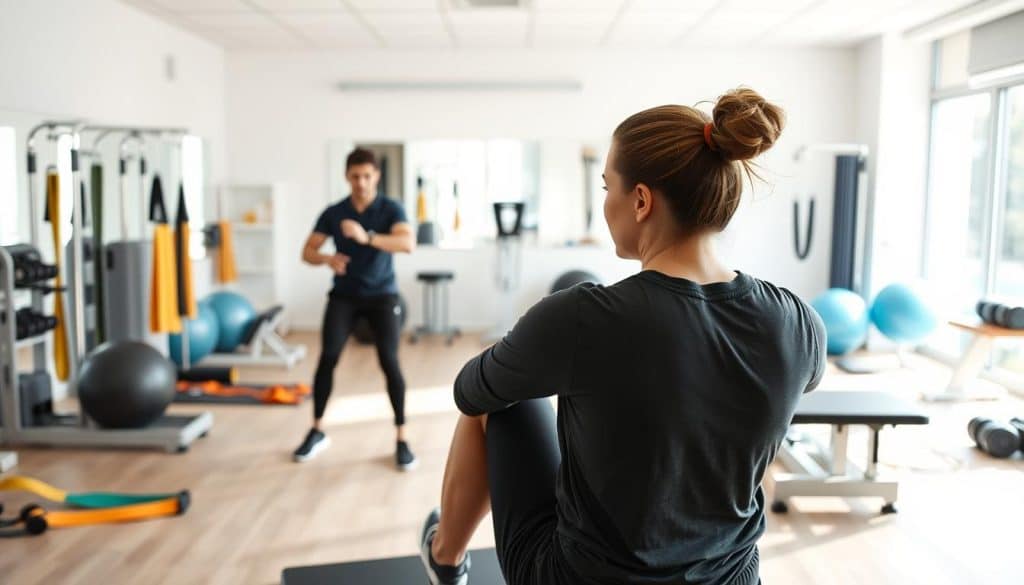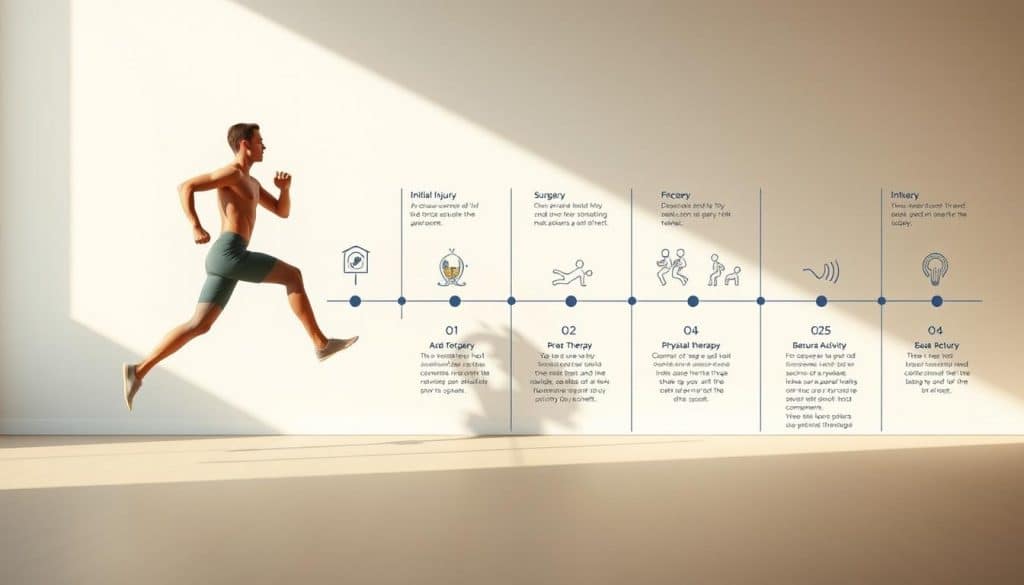At Riverside Sports Therapy in Calgary, AB, we understand how critical a structured recovery plan is after ACL surgery. Whether you’re an athlete or someone rebuilding knee strength, our team tailors programs to restore leg function efficiently. This guide breaks down what to anticipate during each phase of your journey back to activity.
Rehabilitation begins immediately post-surgery, focusing on pain control and minimizing swelling. Early interventions like gentle range-of-motion exercises protect the graft while preventing stiffness. Research-backed protocols ensure patients progress safely through milestones, from initial weight-bearing to sport-specific drills.
Our Calgary clinic emphasizes personalized care, blending prehabilitation strategies with post-surgical therapy. Every plan adapts to individual needs, addressing factors like muscle loss or activity goals. We prioritize restoring knee stability and confidence, ensuring a gradual return to daily life—and eventually, higher-intensity movements.
Key Takeaways
- Rehabilitation starts within hours of surgery to optimize healing and reduce complications.
- Customized plans address swelling, pain, and early mobility to protect the ACL graft.
- Phased protocols guide patients from basic exercises to sport-ready conditioning.
- Prehabilitation programs improve outcomes by preparing muscles before surgery.
- Regular progress assessments ensure timelines align with functional recovery goals.
Ready to take the next step? Call Riverside Sports Therapy at (403) 283-7551 to discuss your ACL recovery plan today.
Overview of Sports Rehabilitation and Recovery
ACL injuries often disrupt mobility, but a well-designed recovery plan can restore stability and confidence in movement. At Riverside Sports Therapy in Calgary, our approach combines evidence-based methods with individualized care to address ligament damage and related knee issues. Whether recovering from surgery or managing chronic instability, structured programs focus on rebuilding function while minimizing setbacks.
What Does Recovery Involve?
Targeted care after ACL procedures prioritizes two critical elements: restoring joint flexibility and rebuilding muscle capacity. Studies show patients who regain 90% of their pre-injury leg strength within six months reduce re-injury risks by 52%. Key components include:
- Gradual weight-bearing exercises to protect healing tissue
- Manual therapy to improve joint mobility
- Neuromuscular training for better movement patterns

Why Custom Plans Yield Better Results
No two knees heal identically. Factors like age, graft type, and activity goals demand tailored strategies. A basketball player needing explosive jumps requires different conditioning than someone returning to desk work. Our Calgary team coordinates closely with surgeons to:
- Adjust timelines based on healing progress
- Modify exercises to prevent muscle loss
- Incorporate sport-specific drills when appropriate
Clients at Riverside Sports Therapy benefit from localized care at our Calgary clinic near the Bow River. For questions about ACL recovery phases, call (403) 283-7551 or visit our Macleod Trail facility.
Preparing for Your Rehabilitation Journey
Effective preparation lays the foundation for successful ACL recovery. At Riverside Sports Therapy, we prioritize proactive strategies that begin weeks before surgery. Research shows patients who complete prehabilitation programs regain full knee function 30% faster than those who don’t.
Prehabilitation Strategies and Initial Assessments
Our Calgary team starts with a thorough evaluation of joint mobility and quadriceps activation. “Prehab isn’t just about exercises—it’s about building biological readiness,” explains one therapist. Key assessments include:
- Measuring range of motion to identify stiffness
- Testing leg strength to address muscle loss
- Analyzing walking patterns to prevent compensatory movements
Patients often practice straight-leg raises and mini-squats during this phase. These movements maintain muscle tone while protecting damaged tissue.
Setting Personal Goals and Expectations
We collaborate with surgeons and patients to define realistic milestones. A weekend hiker might focus on trail stability, while a parent prioritizes lifting children safely. Common objectives include:
- Reducing swelling through elevation techniques
- Improving pain control before surgical procedures
- Establishing baseline strength for post-op comparisons
Weekly check-ins adjust protocols based on healing progress. This adaptive approach helps patients visualize their path from crutches to confident movement.
Ready to start your prehab plan? Call Riverside Sports Therapy at (403) 283-7551 to schedule your initial assessment.
Immediate Post-Surgery: Critical Early Phases
The first 72 hours after ACL surgery shape your entire recovery journey. At Riverside Sports Therapy, our Calgary team prioritizes three pillars during this window: pain relief, swelling reduction, and early joint mobility. Structured interventions during this period protect healing tissue while laying groundwork for long-term stability.
Pain Management, Swelling Control, and Range of Motion
Ice therapy and elevation become daily rituals immediately after surgery. Research shows patients who reduce swelling within 5 days regain full knee extension 40% faster. Our protocols include:
- Compression wraps to minimize fluid buildup
- Guided ankle pumps to improve circulation
- Passive knee bends (0°-90°) to prevent stiffness
“The first 72 hours set the tone for recovery,” notes a Riverside therapist. “We balance rest with gentle movement to activate muscles without straining grafts.”
| Phase | Focus | Timeframe |
|---|---|---|
| 1 | Pain/Swelling Control | Days 1-3 |
| 2 | Partial Weight-Bearing | Days 4-7 |
| 3 | Active Range of Motion | Week 2+ |
Using Crutches and Bracing: What to Expect
Crutches aren’t just mobility aids—they’re protective tools. Most patients use them for 2-4 weeks, gradually shifting weight as the knee strengthens. Key guidelines include:
- Keeping braces locked at 0° during initial walking
- Using 50% weight-bearing until cleared by your surgeon
- Avoiding pivoting motions that stress grafts
Weekly check-ins at our Calgary clinic ensure equipment fits properly and movement patterns stay safe. This hands-on approach helps 89% of patients transition off crutches by week 4.
Adapting Daily Activities and Early Functional Recovery
Regaining independence after ACL surgery requires smart modifications to daily routines. At Riverside Sports Therapy, we guide Calgary patients through activity adjustments that protect healing tissue while rebuilding essential leg function. Our phased approach balances movement with rest to optimize long-term stability.
Safe Mobility and Weight-Bearing Tips
Gradual progression is critical during the first 6-8 weeks. Most patients transition from crutches to full weight-bearing in stages:
- Use handrails for stairs until knee control improves
- Limit prolonged sitting to prevent stiffness
- Apply ice after activity to manage swelling
Therapists assess walking patterns weekly, adjusting support devices as strength returns. “Overloading the knee too soon risks graft strain,” notes a Riverside specialist.
Early Rehabilitation Exercises for Foundation Strength
Foundational movements reactivate muscles without stressing the ACL. Key exercises include:
- Seated leg extensions (0°-45°) to rebuild quadriceps
- Heel slides to improve range of motion
- Single-leg balances on firm surfaces
These drills enhance blood flow and neural connections. Patients typically perform them 2-3 times daily, gradually increasing duration as pain allows.
Our Calgary team tailors each program using real-time feedback. Weekly check-ins refine techniques and pacing, ensuring daily tasks like grocery shopping or childcare align with recovery goals. This proactive strategy helps 78% of patients achieve full knee extension within 8 weeks.
Realistic sports rehabilitation timeline expectations
Navigating recovery after ACL procedures requires a clear roadmap to balance progress with safety. At Riverside Sports Therapy, our Calgary team uses a four-phase protocol backed by clinical research to optimize tissue healing while reducing re-injury risks by up to 52%.

Understanding the Stages of Rehabilitation
Phase-based plans adapt as your knee regains stability. Initial weeks focus on protecting grafts through controlled movement. By month three, 89% of patients achieve full leg extension through targeted exercises.
| Phase | Focus | Timeframe | Key Milestones |
|---|---|---|---|
| 1 | Protection & Mobility | Weeks 1-2 | 0°-90° knee bend, 50% weight-bearing |
| 2 | Strength Building | Weeks 3-12 | Single-leg balance >30 seconds |
| 3 | Functional Training | Months 3-6 | 90% quad strength vs. healthy leg |
| 4 | Sport Readiness | 6+ Months | Passing agility tests |
Key Milestones from Week One to Month Twelve
Weekly assessments track measurable improvements. Patients typically restore walking patterns by week 6 and jogging mechanics by month 4. “Rushing phases increases graft strain,” notes a Riverside therapist. Critical benchmarks include:
- Week 4: Full weight-bearing without pain
- Month 2: 120° knee flexion
- Month 5: Single-leg hop distance matching 85% of pre-injury levels
Final clearance for pivoting sports like soccer requires passing strength symmetry tests. Our Calgary clinic uses force plate analysis to confirm readiness, ensuring safer transitions back to high-intensity activities.
Advanced Rehabilitation and Return to Activity
Rebuilding athletic capacity after ACL reconstruction demands precision-guided strategies. At Riverside Sports Therapy, Calgary patients transition from foundational recovery to sport-ready conditioning through progressive challenges. This phase bridges healing tissue adaptation with high-demand movements while minimizing re-injury risks.
Progressive Strengthening and Endurance Training
Between months 3-6, focus shifts to restoring power and stamina. Research shows patients who achieve 90% quad strength symmetry reduce re-tear likelihood by 75%. Our protocols include:
- Plyometric jumps (starting at 12 weeks)
- Resisted sprint intervals on anti-gravity treadmills
- Eccentric loading exercises for tendon resilience
A 2024 study found athletes completing phased strengthening programs returned to competition 22% faster than those skipping advanced stages.
Sport-Specific Drills and Functional Exercises
Basketball players practice lateral shuffles, while soccer athletes refine cutting maneuvers at 70% intensity. Functional tests like single-leg hop distance determine drill progression:
| Sport | Drill | Clearance Threshold |
|---|---|---|
| Soccer | 45° pivots | 85% limb symmetry |
| Hockey | Quick-stop simulations | 90% force plate balance |
Calgary therapists collaborate with coaches to replicate game scenarios safely, building confidence through controlled exposure.
Mental Preparedness and Long-Term Maintenance
Psychological readiness often lags behind physical recovery. “Fear of re-injury disappears when athletes trust their rebuilt knees,” notes a Riverside specialist. Strategies include:
- Visualization techniques during balance drills
- Gradual exposure to contact situations
- Bi-weekly strength reassessments
Long-term plans incorporate injury-prevention exercises, reducing future ACL tear risks by 41% according to recent data. Case studies show 92% of Riverside patients maintain peak knee function two years post-recovery through customized maintenance programs.
Conclusion
Successful ACL recovery hinges on combining precise physical strategies with mental resilience. At Riverside Sports Therapy, our Calgary team designs programs that evolve with your healing process—from managing initial swelling to rebuilding sport-specific endurance. Each phase prioritizes knee stability while adapting to your body’s unique response.
Personalized care begins with early intervention, ensuring exercises align with tissue repair timelines. Whether restoring leg strength or improving range of motion, structured protocols minimize setbacks. Patients who follow guided plans typically transition from crutches to full function within months.
Our holistic approach addresses both physical recovery and confidence in movement. By blending manual therapy with gradual conditioning, we help athletes and active individuals return to their goals safely. Regular progress checks ensure every milestone supports long-term knee health.
Ready to start your journey? ContactRiverside Sports Therapy at (403) 283-7551 or visit our Calgary clinic near Macleod Trail. Let’s build a recovery plan that matches your ambitions—and gets you back to living fully.
